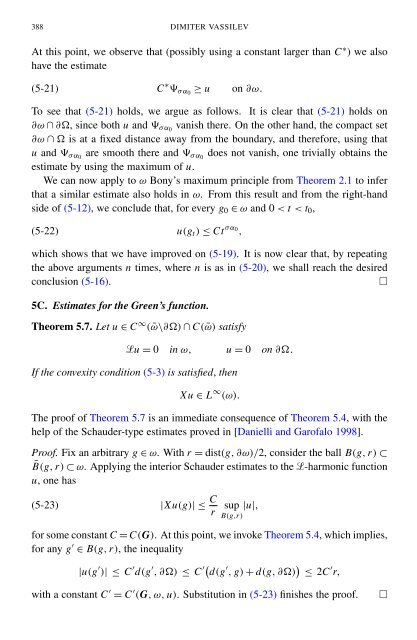Regularity near the characteristic boundary for sub-laplacian operators
Regularity near the characteristic boundary for sub-laplacian operators
Regularity near the characteristic boundary for sub-laplacian operators
Create successful ePaper yourself
Turn your PDF publications into a flip-book with our unique Google optimized e-Paper software.
388 DIMITER VASSILEV<br />
At this point, we observe that (possibly using a constant larger than C ∗ ) we also<br />
have <strong>the</strong> estimate<br />
(5-21) C ∗ σ α0 ≥ u on ∂ω.<br />
To see that (5-21) holds, we argue as follows. It is clear that (5-21) holds on<br />
∂ω ∩ ∂, since both u and σ α0 vanish <strong>the</strong>re. On <strong>the</strong> o<strong>the</strong>r hand, <strong>the</strong> compact set<br />
∂ω ∩ is at a fixed distance away from <strong>the</strong> <strong>boundary</strong>, and <strong>the</strong>re<strong>for</strong>e, using that<br />
u and σ α0 are smooth <strong>the</strong>re and σ α0 does not vanish, one trivially obtains <strong>the</strong><br />
estimate by using <strong>the</strong> maximum of u.<br />
We can now apply to ω Bony’s maximum principle from Theorem 2.1 to infer<br />
that a similar estimate also holds in ω. From this result and from <strong>the</strong> right-hand<br />
side of (5-12), we conclude that, <strong>for</strong> every g 0 ∈ ω and 0 < t < t 0 ,<br />
(5-22) u(g t ) ≤ Ct σ α 0<br />
,<br />
which shows that we have improved on (5-19). It is now clear that, by repeating<br />
<strong>the</strong> above arguments n times, where n is as in (5-20), we shall reach <strong>the</strong> desired<br />
conclusion (5-16).<br />
□<br />
5C. Estimates <strong>for</strong> <strong>the</strong> Green’s function.<br />
Theorem 5.7. Let u ∈ C ∞ ( ¯ω\∂) ∩ C( ¯ω) satisfy<br />
u = 0 in ω, u = 0 on ∂.<br />
If <strong>the</strong> convexity condition (5-3) is satisfied, <strong>the</strong>n<br />
Xu ∈ L ∞ (ω).<br />
The proof of Theorem 5.7 is an immediate consequence of Theorem 5.4, with <strong>the</strong><br />
help of <strong>the</strong> Schauder-type estimates proved in [Danielli and Garofalo 1998].<br />
Proof. Fix an arbitrary g ∈ ω. With r = dist(g, ∂ω)/2, consider <strong>the</strong> ball B(g, r) ⊂<br />
¯B(g, r) ⊂ ω. Applying <strong>the</strong> interior Schauder estimates to <strong>the</strong> -harmonic function<br />
u, one has<br />
(5-23) |Xu(g)| ≤ C r<br />
sup |u|,<br />
B(g,r)<br />
<strong>for</strong> some constant C = C(G). At this point, we invoke Theorem 5.4, which implies,<br />
<strong>for</strong> any g ′ ∈ B(g, r), <strong>the</strong> inequality<br />
|u(g ′ )| ≤ C ′ d(g ′ , ∂) ≤ C ′( d(g ′ , g) + d(g, ∂) ) ≤ 2C ′ r,<br />
with a constant C ′ = C ′ (G, ω, u). Substitution in (5-23) finishes <strong>the</strong> proof.<br />
□
















